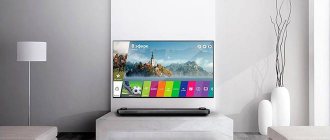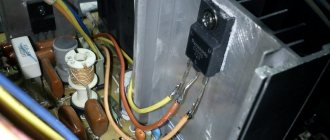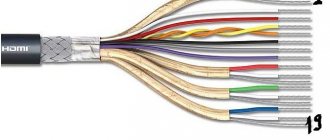TVs serve uninterruptedly for 5 years or more. But sometimes a few specks appear and do not change color even after a reboot. No need to worry - in most situations this problem is fixable. You can read below how to deal with dead pixels on your TV.
Please note: Optimal TV diagonal - a 3-point guide on choosing a screen size
What is a pixel on a TV
Pixels are the units of the LCD screen matrix that create any image. The main property of a pixel is its ability to change color: electricity, the amount of which is regulated by a transistor hidden in the TV, causes microelements of liquid crystals to change their location.
Thanks to the rearrangement of red, green and blue subpixels and the intensity of the backlight, one or another color is formed at a certain point on the monitor - if a TV device has 4K resolution and displays content at a speed of 30 FPS, more than 250 million such “castlings” can occur per second.
Dead pixels on a TV are the smallest elements of the display that do not change color under any conditions.
Although this defect is practically invisible to the human eye during dynamic cinematic scenes, the user may experience discomfort when viewing static images: “broken” dots stand out clearly against the general background and make it difficult to concentrate on the TV picture displayed.
JScreenFix
Restoring pixels on a monitor is successfully achieved through this free virtual service. Its advantage is that it is available on any device with Internet access - not only on a PC and laptop, but also on a smartphone, TV, e-reader or tablet.
JScreenFix operates similarly to the previous program. There is only one difference - the recovery parameters (frame rate, impact size) here cannot be adjusted independently. In addition, during the “treatment” JScreenFix will not be able to work with the device. If the problem does not appear in the browser window, then the service can be expanded to full screen.
The creators of JScreenFix also recommend periodically running their product to prevent the problem.
Allowable number of dead pixels
Each TV manufacturer declares an acceptable level of dead pixels in the matrix - products, during a pre-sale inspection of which a number of defects exceeding the established limit were identified, should be considered defective.
Top companies such as Samsung and LG allow no more than two completely dark pixels and no more than 5 incorrectly functioning subpixels per million pixels: for example, the already mentioned 4K resolution consists of 8 million matrix units (3840x2160) and therefore can include up to 16 defective pixels and up to 40 “stuck” subpixels.
Since pixels that work properly during factory tests can fail already during the operation of the TV, the manufacturer is obliged to guarantee the full functionality of the matrix for a period regulated by international or domestic requirements.
If there are “extra” dead pixels on the TV display, the user has the right to free repair or replacement of the device.
Interestingly, the generally accepted ISO 13406-2 standard limits a company's liability to one year, while LG's Zero Bright Dot program limits it to three.
Warranty service
Why do manufacturers produce equipment that already has a number of faulty or defective points? The technology for creating monitors or televisions is complex. Not every electronics brand owner decides to start production of LCD displays. Writing off screens with minor defects will lead to a significant increase in the price of the product. Therefore, manufacturers and sellers have found a way out of this situation by offering the buyer monitors with minor defects at a reduced price.
- leave the production of screens at the same levels and produce products in the same volumes without increasing prices,
- buyers will use equipment that has a certain percentage of dead pixels (these cases are not covered by warranty).
But buyers should know and exercise their rights and check the equipment before paying. Pixel testing must be carried out in-store.
But today more and more electronics are bought in virtual stores - via the Internet. Therefore, the customer needs to be able to check for dead pixels at home. For this purpose, special tests or simple but effective programs were created. They are not needed only in cases where dead or burning spots can be detected with the naked eye.
Reasons for appearance
The reason for the appearance of broken dots on the matrix of a color TV may be:
- overheating or hypothermia of the device. As a result of exposure to high or low temperatures, subpixels harden and lose their ability to move inside the liquid crystals;
- ambient humidity. High humidity is dangerous for the LCD substrate: when moisture gets on the matrix, illuminated areas or white dots on the display are formed;
- voltage surges. A failure in the electrical network can lead to the failure of the transistor, as a result of which the energy supplied to the RGB matrix will force the subpixels to take a fixed position;
- violation of production technology. It is worth saying that in most cases, manufacturing defects are caused by only the three factors presented above - during the production of the matrix, repeated procedures of washing, drying and lithography are carried out, the slightest non-compliance with the technological processes of which leads to defectiveness of the final product;
- using a monitor to display static content. When displaying the same picture for a long time, the display transistor may burn out and the crystals may “freeze.” Even TVs that support HDR technology (10-bit and Dolby Vision) are not immune to this problem.
Also, the matrix may be damaged during careless transportation of the TV device to the point of sale: despite the strong fixation in the substrate, liquid crystals are very sensitive to sudden mechanical shocks.
Checking the display before purchasing
The TV market is booming right now. Before we had time to enjoy 4K resolution, this format had already become widespread - and 8K models arrived on store shelves. However, the race between technologies (OLED, QLED, LED) and the number of pixels is secondary. Primary is the quality of the image, which you will have to live with, and the ability of the TV to efficiently display even broadcasts, compressed files and similar content, which, one way or another, is still widespread. That is, of course, it’s great to surprise guests with a video in 8K, but after that you’ll have to watch “Girls” (1961), which even in 1080p lacks stars from the sky. And this is where our new guide to choosing and setting up a TV will help you. Go!
Disable all picture enhancers and noise suppressors
Out of the box, almost all TVs have a noise reduction and additional image enhancement system activated at the factory. In most cases, they lead to blurring of the frame and make it unnatural. Of course, it’s worth experimenting with this - but only later. The quality of the device’s operation should be assessed by disabling the improvers. And if there is an image selection mode, it should be switched to “Cinema”.
Reduce backlight intensity
The crazy glow of the screen, which many modern LCD TVs flaunt, can significantly reduce the depth of the black field. To begin, reduce the backlight intensity to 50% and proceed to the next step.
Calibrate Brightness
Picture adjustment tables are quite simple; they are now on many discs, games, videos or as still images. The point is to move the brightness slider so that the figures on the sides of the image are barely visible.
Adjust contrast using a special table
The contrast is adjusted in the same way - thus, in a couple of minutes we achieve the highest possible detail from the TV in both night and day scenes.
Disable Motionflow
The image quality degrades not only from noise reduction, but also from changes in motion transmission algorithms. Additional frame sampling turns the movie into a “soap opera” - disable these functions immediately.
Calibrate your color rendering
It is best to judge colors in an image with skin tones. Your goal is to achieve a natural skin tone. Afterwards, you can evaluate the picture with grass or water and make additional adjustments. An ideal test with a colorimeter is a rather complicated matter, but for many TVs on the Internet you can find settings for ideal color rendition - this is worth taking advantage of.
Run a scene with active camera movement
The crash test for many TVs is to quickly move the camera. If the device “tears” the picture (we are, of course, talking about output at the exact frame rate), then this nuance will haunt you for the entire life of the TV. Pay close attention to this point.
See the depth of the frame in night moments
Fire up a Blu-ray disc with a night scene rich in detail, like the battle sequences from The Lord of the Rings Part 2. A good device will show a lot of details, a bad one will fill everything with darkness.
Check the TV performance on low-resolution material
As noted above, you will watch TV not only on reference content. An old DVD will be a great help in checking the quality of scaling and the correctness of working with standard definition material.
10. Evaluate the display performance in bright light
Many devices can achieve a good picture in the dark.
But you don’t need a TV for this – that’s the prerogative of the projector. But how good will the device be in a sunny living room? Will he be radically lost in the depths of the black field? Be sure to check this point - turn on the lights in the hall to maximum. Denis Repin
November 16, 2021
Editorial staff of Hi-Fi.ru
Subscribe to our Yandex.Zen feed
How to check your TV for dead pixels
To see broken elements of the TV matrix, it is recommended to use a special gallery of monochromatic images - there are no programs compatible with Smart-TV for checking the display.
The screen testing algorithm is presented using the example of searching for white dots:
- Upload a special collection of images to a flash drive.
- Connecting a removable drive to the TV via a USB interface.
- Opening a single-color picture on the TV (in this case, black).
- Inspection of the display: white broken elements should be clearly visible against a dark background.
To search for black dead pixels, you will need to use a light image, and to identify RGB defects, you will need to use any background that contrasts with the bug you are looking for.
Unfortunately, the user must rely only on the acuity of his own vision, since it is impossible to automate the described process.
External inspection upon purchase
Some resellers provide a paid service for checking the LCD display for dead pixels: the user selects a TV, and the sales consultant tests the display using images uploaded to the device.
It is worth saying that paying for such a service makes sense only if you need to check a 4K monitor, the defective pixels of which are almost invisible against the backdrop of millions of working units.
Warranty case
The service center does not have the right to refuse the consumer to exchange a defective TV for a new one only if the manufacturer violates ISO 13406-2 regulations.
The standard describes the permissible number of broken display matrix elements for a particular class of device:
| Display class | Number of illuminated elements | Number of “black” pixels | Spot color errors | Clusters (groups of 2 or more broken elements) |
| I | 0 | 0 | 0 | 0 |
| II | 2 | 2 | 5 | 0 |
| III | 5 | 15 | 50 | 0 |
| IV | 50 | 150 | 500 | 5 |
You can find out the display class from the technical documentation supplied with the TV. Next we will tell you what to do if you receive a refusal from the service center.
Checking the contents
The number and names of accessories differ depending on the purchased model, but the following remain common to all:
- remote control,
- stand,
- connection cables,
- documentation - instructions, warranty card.
What exactly is required for your TV can be checked on the manufacturer’s website and in the documents included with the equipment.
Find out: How to connect speakers to your TV - all methods for 6 types of speakers










